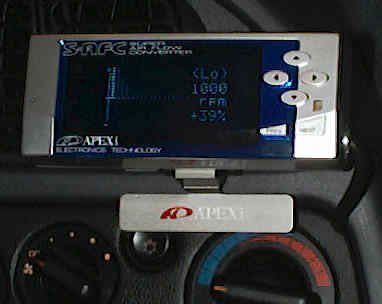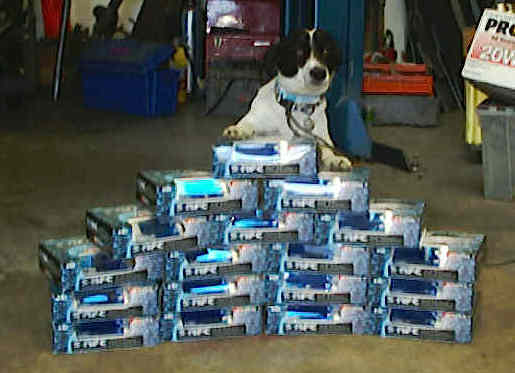

Due to the complexity of the AFC we will only be
able to provide technical support for
our customers. The information here refers specifically referenced to the
Mitsubishi Eclipse and EVO.
Click on the image for full size chart (500K) |
This flow chart helps to understand the features of the new AFC. Starting at the top right, you have a choice of three screens. Monitor, Setting, and Etc. Monitor gives you all the gauge, graphic and numeric monitoring features. The Setting screens allow you do adjust the AFC. The Etc. screen is primarily for set up. |
Super AFC Tuning TipsPurposeThe Air Flow Converter takes the pulse (frequency) from the Mass Air
Flow meter and either speeds it up or slows it down at different RPM
points to make the ECU run the injectors either richer or leaner. All by
itself, it can only give you a little more bottom end power by leaning
out the mix some. If you try to richen the top end you will just hit fuel
cut (100% fuel inj. pulse) sooner. The best use for the AFC is to install larger injectors (runs richer) and then adjust the AFC leaner to compensate. This also raises the point where you hit fuel cut since the ECU sees less air flow (lower frequency Hz). Installation is simple, and only requires tapping into 5 wires and cutting one to intercept the air flow signal. This is all done at the ECU. There are 8 RPM adjusting points to adjust the air flow + /- 50%. These points are user defined within a 1,000 RPM band so that you can get finer control in certain areas if you need it. The rpm points come pre set at every thousand rpm from 1,000 to 8,000. The graph is highlighted for the rpm range you are setting. The Super AFC also allows for two different maps according to load. It makes the load calculation based on the Throttle Position Sensor. You choose what is high and what is low. We normally set it for 30% low and 80% high. Initial AFC Tuning (Low)While in neutral, try revving the engine to the exact RPM settings on the AFC. Hold the RPM, and then start playing with the setting for that RPM. Listen to the exhaust. Start on the rich side, the engine will likely sound very "smooth". Slowly work your way lean, you'll start to hear misfires (popping sounds). A good point is probably where things just start to pop a little but are pretty close to "smooth" (rich). Watch the O2 sensor voltage or A/F ratio meter. Normally the voltage will swing back and forth between .2 and .8 volts at idle and part throttle cruising. . As you adjust leaner, the ECU will compensate back richer. Slowly click down leaner so that the LEDs do not come up. You will then see the O2 voltage come back up slowly. This is the ECU re adjusting. Keep going down until the ECU can no longer bring the A/F ratio back up to swinging in the middle LEDs (.2-.8v). From there richen that rpm point back up about 10 percent. That should put you pretty close to 0 to 5% fuel trim at the ECU. Next repeat the same thing driving the car on the freeway. Hold the car at the rpm that you are going to set. Note what percentage you are beginning with and slowly go lower until the ECU can no longer richen things back up. Go richer about 10% more and compare that with the compensation percentage that you started with. You should be fairly close. When you get things too far out of whack, you will most likely get a check engine light code for Fuel Trim. It just means that the ECU was trying to adjust things to get back between 0.2 and 0.8 volts and couldn't. Don't panic, this is normal. Try to figure out where you were too lean or rich and fix it up. Re-set the ECU and see if the code re-appears. Initial AFC Tuning (High)The higher rpm ranges on the AFC are probably the easiest to tune (if you have an EGT). Use 3rd & 4th gear and go for long runs & watch your EGTs... If the temp gets over 900 Celsius in third gear, you are too lean. We've found that above 5,000 rpm, the settings are typically set very similar to each other. The 2,000 to 3,000 rpm ranges are more tricky because you rarely stay in those RPM's for long & the EGT really won't help you. They'll likely be a little leaner than the higher rpm settings. The 4,000 and 5,000 RPM settings are the most important for maximum power and safety. Typically that is where you first punch the throttle when racing and also where the rpms fall back to when you shift. Try to borrow a digital volt meter meter for your first major tests to prevent against grossly lean situations. Ultimately it comes down to a lot of fiddling around over time. When cruising around, note the RPM's you are at and when you stomp on it, and pay attention to the next two thousand RPM's (it's important to concentrate on RPM ranges and not just overall acceleration...) You start to pick up on when the car is being held back by timing (lean) or if it's running fat. The exhaust sounds a little different (softer) & the power delivery feels different too. Tuning With O2 Sensor VoltageThe stock O2 sensors are not very well matched between vehicles. They will give reasonably repeatable numbers run after run, but you can not compare your numbers with that of another O2 sensor. There are a few O2 sensors that have instrument grade accuracy but they run $800 and up. They also have a very short life span at that accuracy. Oxygen sensor voltage output will also vary with the temperature of the sensor. High end O2 sensors and their monitoring devices have complex circuitry to compensate for this. The Blinky Light meters out there like Cyberdyne, Autometer, and EFI's Dual Meter are perfectly accurate at reading the voltage from the O2 sensor and lighting up the proper LED. The problem with them is when relying on them for full throttle tuning is that the range is not fine enough. There is a huge performance difference between .90v and .96v. Both of those voltages will light up the top most LED on these gauges. The LED based gauges do have their purpose in tuning closed loop/part throttle at a glance. For more accuracy, a digital volt meter is much better. For the best of both worlds, use the digital A/F Ratio meter from Zeitronix Bottom line is tuning with is fine with your own O2 and multi-meter but the numbers you are reading really have no relationship to anyone else's numbers to within .02v. High EGTs and KnockIf you are running too lean for the boost and octane you have in the tank, you will get knock or pre-ignition. The knock sensor bolted to the engine block will pick up this "pinging" sound long before you can hear it inside the car. When under higher boost, there is almost always small amounts of knock. At these small amounts of knock the ECU will continue to advance timing normally. At mid knock levels the ECU will hold timing and if it gets too high or rises quickly, the ECU will begin to retard timing if not pull it all the way back to zero. You can hear the exhaust note change when the timing goes away. It will turn deeper , almost rumbly sounding. When the timing is retarded, the ignition process happens so late that the flame front shoots out the exhaust port when the exhaust valve opens and blows still expanding, really hot gas directly onto the EGT probe. So internally the pistons are barely warm, but the exhaust manifold and turbo get real hot. This is the reason we recommend not running EGTs higher than 900 degrees C. That is the point that timing retard is usually driving the EGTs up. Not that immediate damage is being done, it is just that you are no longer making additional power above that temperature and there is no benefit to running there. "I turned up my boost and the car does not feel any faster"The power can drop off after a while when increasing the boost due to intercooler flow and intake temperature. The trick is to find the lowest boost that still feels strong. You might as well run just what boost you need to make power rather than stressing the turbo and chance detonation on pump gas. Now with race gas it is a different ball game and the max power point should increase so you will want to try turning up the boost another 2 PSI or more. What kind of turbo and intercooler do you have? If you are using the stock stuff, then your boost is limited by the turbo. The most you will get out of it is about 15-16 PSI which is fine on pump gas. If you manage to somehow get more boost you are likely just making hot air and making less power than you would at a lower boost since you are pushing the turbo way past its efficient operating range. If you have a 16G and a decent front mount intercooler in cold weather (50F) you can make around 300 HP properly tuned. If you have a larger more efficient turbo, such as a 20G you can make even more power on pump gas properly tuned. Fuel CutIt's a nice cool night out and your Eclipse was running better than
ever. You were boosting a little higher than you normally do and BAM, the
motor shuts off hard and there is a backfire. You ease back into the
throttle thinking you just blew up something big. The car seems to run
fine. Welcome to Fuel Cut. There are several possible solutions to fuel cut. The dime store FCD works fairly well but is potentially dangerous and doesn't net consistent results. It doesn't really solve the problem but is a partial workaround. The next solution is to get the Fuel Cut removed from the ECU altogether via someone like Keydiver. This definitely does the trick but still doesn't really solve the underlying problem of running lean. Ideally you should install larger injectors and a fuel computer of some kind, like the AFC. Fuel cut is caused by the ECU seeing a large airflow value from the MAF
which works out to roughly 100% duty cycle on the stock injectors. If you
install 550cc injectors which are 18% bigger than the stock injectors,
then adjust the AFC to compensate for the
larger injectors, you won't hit fuel cut until you Also an EGT is generally a good idea once you start running high boost
levels or hitting fuel cut. The ECU thinks you are getting close to
maxing out your fuel system, and the EGT can tell you for sure. It is an
expensive item, but cheaper than an engine. Just get the GReddy
electronic gauge and mount it in the #1 or #2 exhaust runner. You will
also need it to tune the car properly with a fuel computer. |

Last Updated 2/06mw